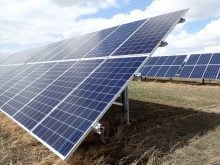The years ahead will see significant solar development. Unfortunately, most all those solar panels seem destined for prime farmland.
What would you do if an independent power provider (IPP) offered you $300 or even $400 an acre each year for the next 25 years to rent a half section or even a full section of your best land? It would be hard to turn down, but the money doesn’t make it the right use for the land.
SaskPower plans to award contracts to IPPs to develop about 300 megawatts of solar generation on land selected and acquired by IPPs in south-central Saskatchewan. Including this 300 MW, Sask Power plans to add 1,000 MW of solar power to the grid by 2035.
Read Also

High prices see cow-calf producers rushing to incorporate
Farm accountants are reporting a steady stream of cow-calf producers rushing to get their operations incorporated ahead of selling their calves this fall.
SaskPower acknowledges there are significant environmental permitting risks associated with developing a project on uncultivated land, so cultivated land is the target. The IPPs want land close to a SaskPower point of interconnection and they prefer flat land that’s easy to develop. Of course, they also require landowners willing to sign a lease.
According to SaskPower estimates, it takes seven acres of land to produce a megawatt of power so the 1,000 MW target will only require 7,000 acres province-wide. As SaskPower points out, this is a minuscule percentage of the total agricultural land in the province.
Interestingly, the Saskatchewan Farmland Security Board has granted 17 exemption requests over the past four years for wind and solar power development. This includes options to lease land. The total acreage involved in the exemptions is more than 540,000 acres.
Companies have likely applied for far more acres than will ever be used, but it’s still a startling number. By comparison, the exemptions for mining, forestry and petroleum projects over the past four years are in the range of only 50,000 acres.
Once land is under solar panels, you can try to establish grass and then keep it mowed. Theoretically, you could graze sheep under the panels, but that seems unlikely in most cases.
With any sort of development, a NIMBY factor comes into play (not in my backyard). That aside, it still makes little sense to idle highly productive land when marginal or industrial land might be available. Under the current system, minimizing construction costs is more important than the value of lost production.
Jessica Nixon, director of economic development for Cowesssess First Nation, is proud of her work to bring renewable energy projects to reserve land. However, as a grain and cattle farmer, she’s concerned about the loss of farmland to solar projects. Nixon wrote a recent opinion piece on the topic.
“The issue at hand is renewable energy developers do not factor the lost agricultural productivity of farmland into their financial models,” wrote Nixon. “If renewable energy developers are not bound by any regulations of the agricultural value of the land they use, they will simple choose the land that has the lowest development cost.”
Nixon is not saying solar projects shouldn’t proceed and she isn’t even saying solar projects should only proceed on uncultivated land. What she suggests is that additional consideration needs to be given to selecting land that is in a marginal soil class or land that requires remediation from other industrial uses, such as waste lands from mining.
Nixon makes a lot of sense. Now is the time to set the rules and strike a better balance on site selection for solar power.
Kevin Hursh is an agricultural journalist, consultant and farmer. He can be reached by e-mail at kevin@hursh.ca.
















